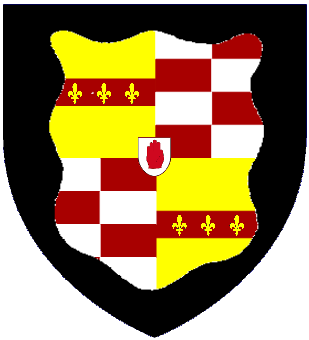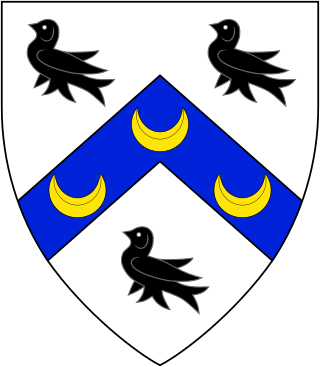Related Research Articles

Baron Shuttleworth, of Gawthorpe in the County Palatine of Lancaster, is a title in the Peerage of the United Kingdom. It was created on 15 July 1902 for the Liberal politician Sir Ughtred Kay-Shuttleworth, 2nd Baronet. Both his sons were killed in the First World War and he was therefore succeeded by his grandson, the second Baron. However, both he and his brother, the third Baron, were killed in action during the Second World War. On the death of the third Baron in 1942 the titles passed to his first cousin, the fourth Baron, who survived the Second World War although he was badly wounded. As of 2017 the titles are held by the latter's son, the fifth Baron, who succeeded in 1975. He has been Lord Lieutenant of Lancashire since 1997.

There have been three baronetcies created for persons with the surname Croft, one in the Baronetage of England and two in the Baronetage of the United Kingdom. All three creations are extant as of 2008.

Charles Compton William Cavendish, 3rd Baron Chesham,, styled The Honourable Charles Cavendish between 1863 and 1882, was a British soldier, courtier and Conservative politician. He served as the last Master of the Buckhounds under Lord Salisbury from 1900 to 1901.

The Anson baronetcy, of Birch Hall in the County Palatine of Lancaster, is a title in the Baronetage of the United Kingdom held by a branch of the Anson family. It was created on 30 September 1831 for William Anson. He was the third son of George Anson; his elder brothers were Thomas Anson, 1st Viscount Anson, and General Sir George Anson. Sir William was the uncle of Thomas Anson, 1st Earl of Lichfield, and Major-General George Anson and the great-nephew of George Anson, 1st Baron Anson. His grandson, the third Baronet, was a lawyer and Liberal Unionist politician. He never married and was succeeded by his nephew, the fourth Baronet. He was the only son of Frederick Arthur Anson, third son of the second Baronet. The fourth baronet drowned in the Thames in July 1914, aged only twenty-five. He had not married and on his death the title passed to his first cousin, the fifth Baronet, the eldest son of Rear-Admiral Algernon Horatio Anson (1854–1913), fourth and youngest son of the second Baronet. He was killed in action in the First World War. He was unmarried and was succeeded by his younger brother, the sixth Baronet. His elder son, the seventh baronet, was a Rear-Admiral in the Royal Navy. As of 2021 the title is held by the latter's son, the eighth Baronet, who succeeded in 2018.

The Barrett-Lennard Baronetcy, of Belhus in the County of Essex, is a title in the Baronetage of the United Kingdom. It was created on 30 June 1801 for Thomas Barrett-Lennard, subsequently Member of Parliament for Essex South. He was the illegitimate son and testamentary heir of Thomas Barrett-Lennard, 17th Baron Dacre. He was succeeded by his grandson, the second Baronet, the son of Thomas Barrett-Lennard, Member of Parliament for Maldon. His son, the third Baronet, was childless and was succeeded by his younger brother, the fourth Baronet. This line of the family failed on the death in 1977 of his son, the fifth Baronet, who died without male issue. The late Baronet was succeeded by his third cousin once removed, the sixth Baronet. He was the son of Sir Fiennes Cecil Arthur Barrett-Lennard, Chief Justice of Jamaica, son of Captain Thomas George Barrett-Lennard, son of the first marriage of George Barrett-Lennard, son of John Barrett-Lennard, second son of the first Baronet. The sixth Baronet was a Catholic clergyman. As of 2014 the title is held by his second cousin, the seventh Baronet, who succeeded in 2007. He is the grandson of Trenchard Barrett-Lennard, son of the aforementioned George Lennard-Barrett by his second marriage. As of 31 December 2013 the present Baronet has not successfully proven his succession and is therefore not on the Official Roll of the Baronetage, with the baronetcy considered vacant since 2007.

There have been twenty one baronetcies created for persons with the surname Williams, eight in the Baronetage of England, three in the Baronetage of Great Britain and ten in the Baronetage of the United Kingdom. Only six of the creations are extant as of 2017.
There have been three baronetcies created for persons with the surname Lees, all in the Baronetage of the United Kingdom.
There have been eight baronetcies created for persons with the surname Jackson, one in the Baronetage of England, one in the Baronetage of Great Britain and six in the Baronetage of the United Kingdom. As of 2014 four of the creations are extant.
There have been four baronetcies created for persons with the surname Bell, all in the Baronetage of the United Kingdom. One creation is extant as of 2007.
There have been three baronetcies created for persons with the surname Power, all in the Baronetage of the United Kingdom.
There have been five baronetcies created for persons with the surname Evans, one in the Baronetage of Ireland and four in the Baronetage of the United Kingdom. All of the baronetcies are now extinct.

Lieutenant-Colonel Sir Elliott Lees, 1st Baronet, DSO, was a British Conservative Party politician.

There have been seven baronetcies created for persons with the surname Watson, one in the Baronetage of England, one in the Baronetage of Great Britain and five in the Baronetage of the United Kingdom. One creation is extant as of 2016.

The Chetwynd Baronetcy, of Brocton Hall in the County of Stafford, is a title in the Baronetage of Great Britain. It was created on 1 May 1795 for Sir George Chetwynd, Kt., of Brocton Hall, Staffordshire, for many years Clerk to the Privy Council. The second Baronet was member of parliament for Stafford and High Sheriff of Warwickshire in 1828. The fourth Baronet served as High Sheriff of Warwickshire in 1875. As of 13 June 2007 the presumed ninth Baronet has not successfully proven his succession and is therefore not on the Official Roll of the Baronetage, with the baronetcy dormant since 2004.
There have been two baronetcies created for persons with the surname Mackworth, one in the Baronetage of England and one in the Baronetage of Great Britain. One creation is extant as of 2008.

The Wombwell Baronetcy, of Wombwell in the County of York, is a title in the Baronetage of Great Britain. It was created on 26 August 1778 for George Wombwell, Chairman of the Honourable East India Company and Member of Parliament for Huntingdon. The fourth Baronet fought in the Crimean War and took part in the Charge of the Light Brigade and in 1861 served as High Sheriff of Yorkshire. As of 13 June 2007 the presumed seventh and present Baronet had not successfully proven his succession to the title, and is therefore not on the Official Roll of the Baronetage, with the baronetcy considered dormant since 1977.

The Beevor Baronetcy, of Hethel in the County of Norfolk, is a title in the Baronetage of Great Britain. It was created on 22 January 1784 for the prominent agriculturalist Thomas Beevor. The title has descended in the direct line from father to son.

Vice Admiral Sir Trevylyan Dacres Willes Napier, was a Royal Navy officer who went on to be Commander-in-Chief, America and West Indies Station.

Sir Lewis Amherst Selby-Bigge, 1st Baronet was a British civil servant, barrister, and scholar who was Permanent Secretary at the Board of Education between 1911–1925.
Sir Thomas Henry Elliott, 1st Baronet, was an English civil servant. Having entered the Inland Revenue Department in 1872, he rose to be permanent secretary to the Board of Agriculture and Fisheries (1892–1913), and Deputy Master and Comptroller of the Royal Mint (1913–1917).
References
- ↑ "No. 30332". The London Gazette . 12 October 1917. p. 10504.
- ↑ "No. 26867". The London Gazette . 25 June 1897. p. 3569.
- ↑ "No. 27453". The London Gazette . 11 July 1902. p. 4441.
- ↑ "Official Roll of the Baronetage". Standing Council of the Baronetage. Retrieved 18 December 2019.
- ↑ Standing Council of the Baronetage analysis
- Kidd, Charles, Williamson, David (editors). Debrett's Peerage and Baronetage (1990 edition). New York: St Martin's Press, 1990.
- Leigh Rayment' s baronetage page [Usurped!]